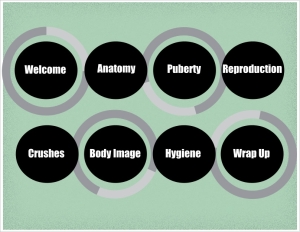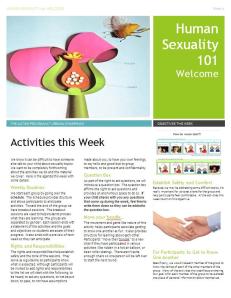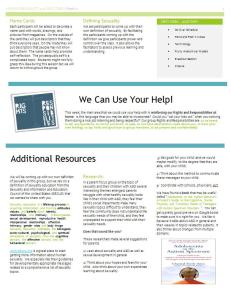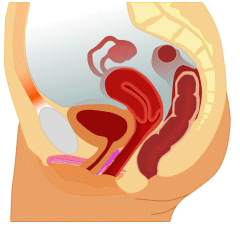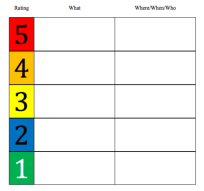These curricula materials are for educators working with young adults. It is a bit more in depth than the high school curriculum and discusses human sexuality in a broader sense.
My Curriculum (free)
These lesson plans are developed by The Birds and the Bees and are free to use or adapt.
Adult Human Sexuality Week 1: Welcome
In the first week of the adult human sexuality class, we focus on meeting the others in the class and establishing a level of respect and expectations for the class.
First, the group will create a list of rights and responsibilities. We’ll start with a writing reflection of what participants think the rights and responsibilities should be. As needed the facilitators will prompt important rights/responsibilities that should be included on the list including: to be heard, to ask any questions, to not be put down, to pass, to not have assumptions made about you, to have your own feelings, to say hello and good-bye to group members, to be present and confidentiality. We will briefly discuss each right/responsibility. These rights/responsibilities will be posted in each session. The rights and responsibilities help establish safety and the tone of the sessions. They serve as a guideline so participants know what is expected.
We will also create a question box and name cards and then there will be an ice breaker activity so the group gets the chance to learn about each other. Then, there will be a discussion about what human sexuality is and discuss the group’s thoughts of human sexuality.
Lesson 1 Materials
Human Sexuality Newsletter Week 1
High School Human Sexuality Curriculum
| This is the session of Human Sexuality 101 was offered by The Autism Program at the University of Illinois Urbana-Champaign. This group was designed for three high school/young adult girls and boys with ASD. The teens in this group were bright and engaging and have had a little formal exposure to sexuality concepts, but still struggle with the more nuanced facets. Many of these activities could be adapted for groups of various sizes and ability levels. |
You can find all of our lesson plans for the high school human sexuality classes here.
8 Week Middle School Human Sexuality Curriculum
Over the summer, I did a 8 week sexuality class with middle school students with autism (3 boys and 3 girls). I’ve posted each lesson from the curriculum, but I thought I’d link all the posts together so you could get to them in one place. For each session there is a lesson plan, parent letter, and power point slides. Some lessons also have worksheets. I’ve also commented about how the lessons went and some ideas for adaptation. Click on the links below to go to the posts and access the materials.
- Lesson 1 Welcome
- Lesson 2 Anatomy
- Lesson 3 Puberty
- Lesson 4 Reproduction
- Lesson 5 Crushes
- Lesson 6 Body Image
- Lesson 7 Hygiene
- Lesson 8 Wrap up and Review*
*We sent home a workbook with follow up/supplemental material during this lesson. The workbook is available on the post.
High School Human Sexuality 101 Week 1: Welcome
This summer, at TAP in Urbana-Champaign, we are doing an eight week human sexuality group for middle school students. We have three boys and three girls in our group who range in age throughout the middle school years (from starting 6th grade to finishing 8th grade). Check out the slides that accompany the lesson.
Our first week was a blast. You can check out the full curriculum here [Sex Ed week 1]. We used a worksheet to help the students come up with their own definition of human sexuality. I love the definition we came up with as a group, “Sometimes human sexuality topics make us feel uncomfortable, but it’s a part of life, specifically, part of our private life. Human sexuality is about how we feel about people like loving someone and liking someone, but sometimes two people’s feelings may not match with each other. Human sexuality has to do with emotions, the body, and relationships.”
We sent a letter home with parents that explained the activities with fairly significant detail, touched on next weeks activities, and provided additional resources. One of the important parts of this letter was suggestions for ways to incorporate these topics at home. This week, as it was mostly about introductions, the parent component focused on using the rights and responsibilities at home.
High School Human Sexuality 101 Week 2- Anatomy
Anatomy and Reproduction were the topics for week 2. We started off the session with a game called “Parts and Post-it Notes” to talk about body parts with the participants. To play this game we had a giant piece of paper with the outline of a body on it. We gave the participants post-it notes to write down the body parts that they knew and asked them to place them on the outline of the body.
After this activity, the participants were told that for the rest of the class they would be focusing on body parts related to reproduction (another way to refer to sex organs or private parts). The participants were then directed to the next activity where they practiced saying terminology related to reproduction out loud and recording their responses to how saying the words made them feel.
When the participants finished the terminology activity, we spit them into two groups to start the fruit anatomical model of reproductive organs using fruit. The participants were shown a picture of the parts of the body and were giving tooth picks and flash cards to label the fruit parts and their functions. This activity was great for the participants to learn the vocabulary in a little abstract and safe way! For a more concrete example of reproduction, we used the “Miracle of Life” video to explain the process.
We ended this session by having the participants briefly summarize that they learned during the session.
For more information on anatomy view our Human Sexuality 101 Week 2- Anatomy, EXPLAINING ANATOMY, YOUTUBE EDUCATIONAL RESOURCES: HEALTHCHANNEL, SEXPLANATIONS, AND CSPH, ADULT HUMAN SEXUALITY WEEK 2- ANTATOMY & REPRODUCTION posts
This Week’s Materials
High School Human Sexuality 101 Week 3: Body Image Lesson Plan
 This lesson plan revolved around teaching what body image means, understanding that people feel differently about their bodies, and that people change how they feel about their bodies over time. After doing several knowledge based activities, we moved to exploring how the students felt about their own bodies.
This lesson plan revolved around teaching what body image means, understanding that people feel differently about their bodies, and that people change how they feel about their bodies over time. After doing several knowledge based activities, we moved to exploring how the students felt about their own bodies.
There was one theme that was really relevant for the student we were working with. She was really interested in her perception of self and others perception of her. In her self-portrait, she focused on the things that make her her; most of these were things you couldn’t see.
We also read body stories. Each had a picture of a body. Just seeing the images was really moving. We were planning mostly for girls, but I included a story that might be more appropriate for a male audience. The young woman chose to read the story about the women who was the most traditionally beautiful (not really a big surprise). This was a story about a woman with chronic illness. Serendipitously, the body story resonated concepts that this student was working through.
Materials
Body Stories (all female) from This is Who I Am by Rosanne Olson (her website is http://bodyimagebook.com)
Body Story (male)
High School Human Sexuality 101 Week 4- Crushes
During week 4, we focused on understanding crushes.
There were three activities for the participants this week:
What is a crush?
The participants first brainstormed things that a person with a crush might feel or think. Participants had different levels of understanding on what having a crush meant to them. The purpose of this activity was to help the participants to understand that crushes are a special set of thoughts and feelings about another person. We later discussed thoughts and ideas that the group may have that may be unsafe when it comes to having a crush.
How to deal with a crush?
We used three videos to help the participants to understand how to deal with a crush. The videos covered these topics: What if you like a friend, How to tell if a guy likes you, and How to get a guys attention. These videos give concrete ways to deal with a crush.
Turning someone down
We used a video about how to say no to deal with a variety of situations when it comes to turning someone down.
For more information and activities on crushes visit our Human Sexuality 101 Week 5- Crushes and Adult Human Sexuality Week 3- Crushes curriculum
This Week’s Material
High school Human Sexuality 101 Week 5- Intimacy
 Intimacy was the focus of week 5. This concept can be difficult to understand because it is very broad so this is how we talked about it in our class.
Intimacy was the focus of week 5. This concept can be difficult to understand because it is very broad so this is how we talked about it in our class.
We talked about how intimacy can be divided into two parts: physical and emotional. Physical intimacy involves expressing ones feelings for another person through a physical manner (holding hands, hugging, kissing, and sexual activity). While emotional intimacy involves the feelings towards another person. It is based on how comfortable you are with someone and how much you can share with them. It is important to understand that there are levels to intimacy and that it is not necessarily just for two people in a dating relationship.
For this week’s activities, we opened up with a discussion on the numerous ways to have intimacy with someone. During group time, our plan was for participants to create a “Intimacy Chart”.
We provided them with pictures displaying different types of intimacy ( holding hands, hugging, etc.) and asked them to write down how each of the pictures made them feel. After that we arranged the picture in order to what we felt would be the natural progression of relationships. To finish off the activity we categorized each picture based on whom we are comfortable doing those actions with. The main purpose of the “Intimacy Chart” is to help the participants to visualize the different types of intimacy.
Although this was the plan, one of our students had a different idea of how she should do this activity. She asked for a folder and then decorated it with her boyfriends name. She then put the different acts of intimacy she felt comfortable with in the folder. At first, she didn’t want to share which behaviors she had chosen, but then she decided that she would share. What a great spontaneous adaption!
For more information on intimacy visit our Intimacy Activities and Adult Human Sexuality Week 6- Physical Intimacy and Human Sexual Response
This Week’s Material
Adult Human Sexuality Week 2- Antatomy & Reproduction
You’re probably sick of seeing my fruity anatomical models, but I just can’t help myself from teaching them- at least I gave you a different picture. I love that activity. One of the participants in the class has trained to be an EMT and is now working on becoming an nurses assistant so he was able to explain the reproductive processes and anatomy. On the other hand, other folks had a hard time looking at pictures of the developing fetus and seeing progression from cells to a more complex organism. I think there just wasn’t enough context and exposure to those images. All the participants in our class had this piece of sex ed before so they knew all the basic parts of anatomy. We got into a nice discussion about reproductive anatomy and why it’s private and why it’s taboo.
When talking about reproduction, be careful not to limit conception to just intercourse (although this is critical information too). In our activity we framed sperm entering the vagina as through intercourse or a medical procedure. You could go into more depth and talk about different fertility options. Why? First, intercourse is not the only birth story and specifically it’s less likely to be the birth story for children with gay or lesbian parents. I think it’s important not to assume that heterosexuality is the norm. Second, many individuals have difficulty conceiving and need fertility support. I think it’s important not to assume fertility is the norm.
For the supplemental materials my co-facilitator and I got into an interesting situation. The book she wanted to use was only available in the children’s section at the public library. It was a really nice resource, but we were concerned about sending adults to the children’s section. All the reproduction books with pictures were in the children’s not fiction section. In the end, we decided to include it, but put a warning where it was located. I’m not sure this was the best choice, but that’s what we went with at the time. We also encouraged participants to watch “Life’s Greatest Miracle”. This is a great teaching tool, and they could stream it for free!
I’ve attached the lesson plan and supplemental materials below.
Materials
- Anatomy & Reproduction lesson plan
- Anatomy & Reproduction Worksheet Packet
- Anatomy-cheat-sheet (explains reproductive organs and their functions at two levels)
- labels (for fruity anatomical models)
- Reproduction Level 1 (this one has fewer pictures and the language is a little simpler)
- Reproduction Level 2 (this is more appropriate for individuals with no cognitive impairments)
- Connections Newsletter Week 2 (this is a newsletter that goes home with participants and expands on topics covered in the class)
Adult Human Sexuality Week 3- Crushes
The main activity this week was a series of worksheets designed around walking participants through the steps of having a crush: places to meet someone, why you notice someone, deciding to talk to them or not, signs of being interested, approaching someone, asking out on a date, and saying “No”. Probably the most difficult question on the worksheets was, “why do you notice this person?” Many of the participants focused on things the would like if they got to know someone. It took several prompts, but they were able to start thinking about the things they notice about others, the things that draw their attention. When we got to different ways to approach someone there were many questions on bar etiquette. We talked about buying drinks for others, when it’s expected to approach people and when it’s not, and the difference between the bar sitting area and table sitting area. We didn’t get to our final activity, but were were going to sequence the road map with pictures of couples at different stages. We have a little bit of a time management problem because there’s no clock in the room. It’s the little things!
We gave them two additional resources this week. First we sent them to a website on how to build self confidence. We also suggested the book, What Men With Asperger Syndrome Want to Know About Women, Dating and Relationships by Maxine Aston.
Get all the materials for this weeks lesson
Adult Human Sexuality Week 4- Dating
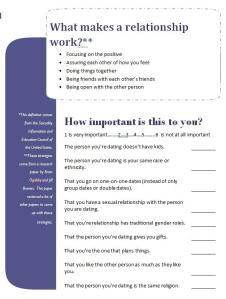 The previous week focused on crushes so this week’s topic, dating, was a natural extension. We did a lot of role playing and it went wonderfully. We were able to pull out parts of the role play to reinforce many of the different concepts. The last time I had done role playing was with middle school students- adults are just so much different to work with. They took the role plays very seriously and put a lot of effort in. One of the actors did turn out to have a comedic streak so the activity was fun as well as thoughtful.
The previous week focused on crushes so this week’s topic, dating, was a natural extension. We did a lot of role playing and it went wonderfully. We were able to pull out parts of the role play to reinforce many of the different concepts. The last time I had done role playing was with middle school students- adults are just so much different to work with. They took the role plays very seriously and put a lot of effort in. One of the actors did turn out to have a comedic streak so the activity was fun as well as thoughtful.
We also did an activity where we asked participants to think about the characteristics in a relationship that were most important to them. We had a couple red flags on the list (like one about physical mutuality) and they were all tuned into why that is important. This activity lead to a nice open discussion where we talked about other items on the list that were important to us. For the most part, people in the group are really centered on having similar interests and values.
Free free to use the materials we’ve developed.
Materials for this week
Adult Human Sexuality Week 5- Power in Relationships
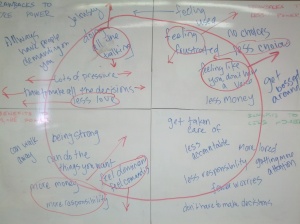 For those of you who have come to a workshop, this activity was similar to what we did in the workshop. We thought about power and control in relationships and specifically the benefits of having more power, benefits of having less power, drawbacks to having more power, and the drawbacks to having less power. Once we got it all up on the board we used put a circle in the center and talked about how different situations would be red flags that a relationship would be unsafe. We also did a shortened version of the “What Should I do Worksheet” and role played some of the different scenarios (like one friend calling another friend because her boyfriend just told her there was a greater age difference than she assumed).
For those of you who have come to a workshop, this activity was similar to what we did in the workshop. We thought about power and control in relationships and specifically the benefits of having more power, benefits of having less power, drawbacks to having more power, and the drawbacks to having less power. Once we got it all up on the board we used put a circle in the center and talked about how different situations would be red flags that a relationship would be unsafe. We also did a shortened version of the “What Should I do Worksheet” and role played some of the different scenarios (like one friend calling another friend because her boyfriend just told her there was a greater age difference than she assumed).
We want more people to get good sexuality education so feel free to use our materials. If you improve on them, let me know!
This Weeks Materials
- Connections Lesson Plan Week 5 Power in Relationships
- Worksheet packet 5
- Connections Newsletter Week 5
One of the participants in our group loves to do trainings and so we included a online training program to identity dating violence in teen relationships. You may find this site really useful too. Dating Maters offers a 1 hour and 20 minute training that will allow you to identify examples of teen dating violence and understand the consequences of teen dating violence. The training will teach you the risk factors, protective factors, warning signs, and challenges for seeking help for teen dating violence. The material is a good starting place for adult relationships too.
Adult Human Sexuality Week 6- Physical Intimacy and Human Sexual Response
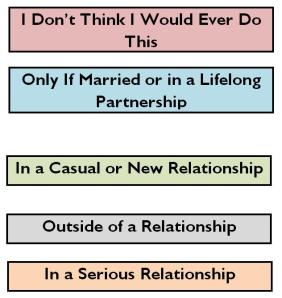 This activity was a little more difficult than we expected (I don’t know why I didn’t expect it to be hard- we’re talking about sexual activity after all!). It was hard for us to explain each of the sexual activities. Part of the point of this activity is to talk about the variety of sexual activities, but sometimes we get caught on our own hang ups and assumptions about what people need to know. On the other hand, this material was difficult and new for many of the participants in the group. Talking about sexual activities can make people feel uncomfortable. I think, in the end we struck a nice balance between expressing the diversity of sexual expression and having opportunities to set personal boundaries. I would make some revisions to the lesson plan and those revisions are reflected in the lesson.
This activity was a little more difficult than we expected (I don’t know why I didn’t expect it to be hard- we’re talking about sexual activity after all!). It was hard for us to explain each of the sexual activities. Part of the point of this activity is to talk about the variety of sexual activities, but sometimes we get caught on our own hang ups and assumptions about what people need to know. On the other hand, this material was difficult and new for many of the participants in the group. Talking about sexual activities can make people feel uncomfortable. I think, in the end we struck a nice balance between expressing the diversity of sexual expression and having opportunities to set personal boundaries. I would make some revisions to the lesson plan and those revisions are reflected in the lesson.
We did a mini pretest which we revisited at the end. The bulk of our activity involved sorting sexual activities into categories and talking about the continuum of intimacy. The relationship categories really helped set up the continuum so I would recommend doing that step first (the relationship categories aren’t listed in order. I would do it from left to right- outside a relationship, in a casual relationship, in a serious relationship, only if married or in a lifelong partnership, and I don’t think I would ever do this). I would then move into talking about how these activities have a continuum. I changed the picture a little to better represent the continuum concept.
We then talked about the human sexual response cycle. As we were talking we used the sexual activities to help make the sexual response cycle more concrete.
We ended with revisiting the pretest questions and talking about our own values. Most of our group really values the emotional components of relationships.
In the newsletter there is a great video for human sexual response that you might want to check out 🙂
If you’re teaching human sexuality and would like to use these materials, go for it.
Materials this Week
Intimacy Activity
This activity can be used to teach about different intimate activities, either alone or with a partner. All of the actions come in a word list form and in a visual form. The activity includes a continuum worksheet in which activities can be classified as “less intimate” and “more intimate”.
One way to use this activity is to teach what sex is. We often assume that people understand what sex is, but people have difficulty with understanding sex even when it is explained. First list the acts of intimacy in a continuum and then discuss “where sex starts” or “which activities are sex and which ones are not. This is more difficult than it seems. For example, it is not uncommon for students to start with thinking that “kissing above the waist over the clothes” is sex. When we teach this activity, we encourage students to express their own understanding of what is more or less intimate but because the concept of a spectrum is difficult, we guide them at the anchors of what is the most inmate and least intimate. By seeing sex in the context of different sexual activities it helps fill in some of the gaps.
Instead of a continuum you could use categories- the categories we use help reinforce the idea of a continuum as well. There is also a list of different levels of intimacy that can be used to classify these activities. Using the activity in this way is consistent with the concept of postponement- postponing intercourse until a relationship is more serious of formalized.
Sometimes when people see all the different acts of intimacy they are surprised but it is important to be inclusive of all different forms of sexual expression. We also don’t use all the different acts with every group, but we’ve given you a pretty comprehensive list that you can tailor to meet your student or child’s needs.
Download the intimacy activity intimacy activity pictures or with just words.

